
Theloderma, the bug-eyed frogs, mossy frogs or warty frogs, is a genus of frogs in the family Rhacophoridae, subfamily Rhacophorinae. They are found from northeastern India and southern China, through Southeast Asia, to the Greater Sunda Islands; the highest species richness is in Indochina. Some species, especially T. corticale, are sometimes kept in captivity.

Theloderma asperum is a frog in the family Rhacophoridae. It is also known as the pied warty frog, hill garden bug-eyed frog, or somewhat informally, bird poop frog. The frog can be found in the northeastern India, Burma, China, Thailand, Cambodia, and Vietnam as well as Sumatra in Indonesia. However, because of confusion with Theloderma albopunctatus and Theloderma baibengensis, it is known with certainty from its type locality in Peninsular Malaysia.

Glyphoglossus guttulatus, also known as Burmese squat frog, blotched burrowing frog, orange burrowing frog, or striped spadefoot frog, is a species of frog in the family Microhylidae. It is found in Myanmar, Thailand, Cambodia, Laos, and Vietnam. It is uncertain whether it is present in the Peninsular Malaysia.

The painted chorus frog is a species of frog in the family Microhylidae. It is found in northeast India, Myanmar, southern China, Hong Kong, Taiwan, Thailand, Cambodia, Laos, Vietnam, Peninsular Malaysia, and Singapore. Its natural habitats are subtropical or tropical moist lowland forest, subtropical or tropical moist montane forest, subtropical or tropical moist shrubland, swamps, intermittent freshwater marshes, arable land, plantations, rural gardens, ponds, open excavations, and irrigated land. It is not considered threatened by the IUCN.
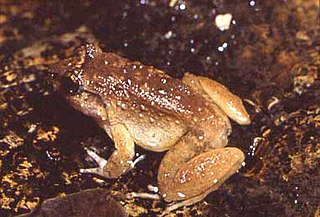
The Koh Chang frog or Koh Chang wart frog is a species of frog in the family Dicroglossidae. It is found in east Thailand and southern Cambodia. Records from Laos and Vietnam represent other species.

The Doichang frog is a species of frog in the family Dicroglossidae. It is only known from its type locality, Doi Chang, mountain north of Chiang Mai (Thailand), Fansipan mountain in northern Vietnam, and Huanglianshan National Nature Reserve in Yunnan, China.
Odorrana jingdongensis is a species of frogs in the family Ranidae. It is known from southern China and northern Vietnam, though it quite likely also occurs in the adjacent areas in Laos and in Myanmar. Its name refers to its type locality, Jingdong Yi Autonomous County in Yunnan. Common name Jingdong frog has been coined for it.

Chirixalus nongkhorensis, also known as the Nongkhor Asian treefrog, Nongkhor pigmy tree frog, Nong Khor bushfrog, and Nongkhor foam-nest treefrog, is a species of frog in the family Rhacophoridae. It is found in north-eastern India (Assam), Myanmar, Thailand, Cambodia, Laos, Vietnam, and Peninsular Malaysia.
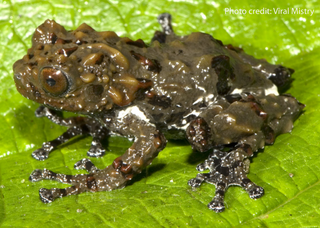
Theloderma moloch is a species of frog in the family Rhacophoridae. It is found in northeastern India and adjacent Tibet, China, possibly wider. Taxonomic placement of this taxon has been a source of much debate, possibly because of wrong tissue was used for it in a molecular study—with ramifications for the taxonomy of whole Theloderma and its sister taxon Nyctixalus.
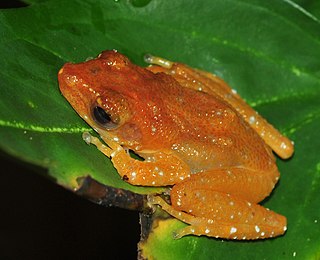
Nyctixalus pictus, also known as cinnamon frog, cinnamon treefrog, cinnamon bush frog, painted Indonesian treefrog, and white-spotted treefrog, etc., is a species of frog in the family Rhacophoridae. It is found in the Malay Peninsula, the Philippines, and parts of the Greater Sunda Islands.

The spiny tree frog is a species of frog in the family Rhacophoridae. It is endemic to the Philippines and occurs on Mindanao, Leyte, Bohol, and Basilan, possibly wider.
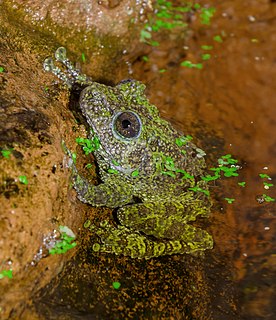
Theloderma corticale is a species of frog in the family Rhacophoridae. It is found in northern Vietnam and China, and possibly in adjacent Laos.
Theloderma horridum is a species of frog in the family Rhacophoridae. It is found in Indonesia, Malaysia, Singapore, and Thailand. Its natural habitat is subtropical or tropical moist lowland forests. It is threatened by habitat loss.

Theloderma leporosum is a species of frog in the family Rhacophoridae. It is found in Peninsular Malaysia and Sumatra (Indonesia).
Theloderma phrynoderma is a species of frog in the family Rhacophoridae. It is endemic to Myanmar and known from two widely separated localities: Thao, its type locality in the Karen Hills in south-central Myanmar where it was collected by Leonardo Fea in 1888, and the Tanintharyi Nature Reserve in southern Myanmar near the Thai border where it was collected in 2009–2010. Common name Burmese bug-eyed frog has been coined for it.
Theloderma stellatum is a species of frog in the family Rhacophoridae. It is found in Thailand, Cambodia, Laos, and Vietnam. Its natural habitats are subtropical or tropical moist lowland forests, subtropical or tropical moist montane forests, and plantations. It is threatened by habitat loss. This species deposits eggs in rain water collected in small tree holes; the tadpoles feed on the organic matter aggregated in a tannin-rich rain water. Notches aiming resin collection increase carrying capacity of the frogs providing additional breeding sites.
Theloderma licin is a frog in the genus Theloderma from peninsular Malaysia and southern Thailand. It is also known as The Smooth Frog. It inhabits lowland to montane forests. IT can be found in water filled tree holes, bamboo cuts, or man-made objects like metal pipes.
Theloderma nebulosum, the misty moss frog, is a species of frogs in the family Rhacophoridae. It is endemic to central Vietnam and currently only known from Ngọc Linh Nature Reserve in the Kon Tum Province. Only one female and a series of tadpoles collected in 2009–2010 are known. This species, together with Theloderma palliatum, was described by Australian and Vietnamese scientists in 2011.
Theloderma palliatum is a species of frog in the family Rhacophoridae. It is endemic to Vietnam and so far only known from the Bidoup Núi Bà and Chư Yang Sin National Parks. This species, together with Theloderma nebulosum, was first found by Australian and Vietnamese scientists in Tay Nguyen in 2011.
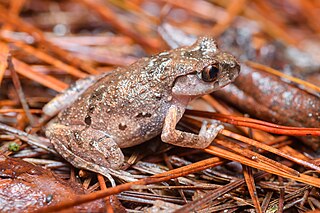
Leptobrachella minima is a species of frog in the family Megophryidae. It occurs in northern Thailand, northern Laos, and northern–central Vietnam.













